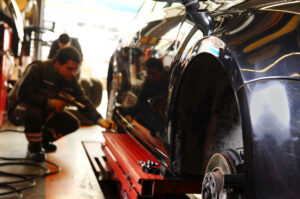
ASE updates collision repair, ADAS & EV standards
By onEducation
The ASE Education Foundation has updated its collision certification standards including, most notably, the creation of a new area of accreditation titled “Collision Repair and Refinish Fundamentals.”
The new area includes 121 distinct skills/tasks and requires a minimum of 300 hours of combined classroom and lab instruction. It draws from the existing areas of accreditation but focuses on five core skill areas highly valued by employers: damaged vehicle disassembly, reassembly, small dent repair, plastic repair, and prep for refinish, ASE said.
The Foundation recently conducted a workshop to review the tasks and tools used by ASE-accredited collision repair and refinish programs in high schools and colleges nationwide. The review committee was made up of vehicle manufacturers, collision repair and refinish facility owners and technicians, instructors and industry trainers, and equipment and parts suppliers.
ASE says its purpose in providing the new accreditation is to give schools and local businesses another path to prepare students for success in entry-level positions with skills that are in high demand.
The updated collision repair and refinish standards als0 include new hybrid and electric vehicle (EV) safety tasks that are required for all students in ASE-accredited collision repair and refinish programs. Two new sections in mechanical and electrical components were also added for advanced driver assistance systems (ADAS) and hybrid and EV service procedures. Those include proper procedures for disconnection of the systems ahead of repairs.
During a Sept. 14 professional development webinar held by ASE to discuss the changes, President Mike Coley said EV safety tasks in the new accreditation are by and large focused on demonstrating knowledge and identification of the components and circuits that are high-voltage. In other words, a very fundamental understanding and demonstrated knowledge of EVs, he sad.
“We want to introduce students to EVs,” Coley said. “Obviously, you could go as far as you want to as far as your budget allows and as far as your Advisory Committee wants you to go but we’re not requiring everyone to start teaching EVs and spend $1 million right now. But, we know that is becoming more and more common in the marketplace.
“EVs are coming, whether you like it or not, and we have an obligation to provide a safe training space and a safe workplace for our students and our employees. That’s the reason that we’re jumping into the EVs, starting with safety.”
A summary of the webinar also states that the new area of accreditation is “intentionally limited in scope to allow students to focus on fundamental skills in collision-damaged vehicle disassembly, reassembly, sheet metal dent repair, plastic repair, and paint priming.”
“Accreditation in Damage Analysis/Estimating/Customer Service is not required for programs accrediting in this area alone, as it is for all other programs. Likewise, Welding, Cutting, and Joining [are] not required for these programs, although they may always include additional instructional content that exceeds the minimum requirements of accreditation.
“The existing areas of accreditation continue to be offered alongside this new area.”
Changes to required tools and equipment to match industry practices are included as well.
The committee also updated “Workplace Employability Skills” to “Foundational Skills” and moved all common safety tasks to that section; all of which are required to be taught by all accredited programs.
Newly added foundational skills include appropriate personal electronic devices, such as cell phones, and workplace inclusion. The latter ensures that “every co-worker and customer feels welcomed, heard, and valued.”
The new standards become requirements come January.
Images
Featured image: Stock photo of work in a repair facility. (Credit: sykono/iStock)
